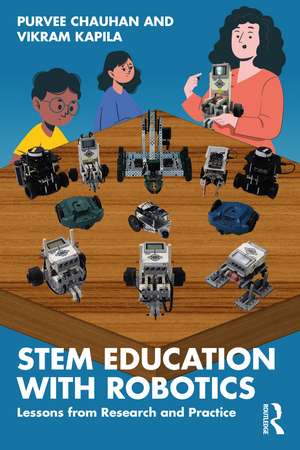STEM Education with Robotics: Lessons from Research and Practice
Autor Purvee Chauhan, Vikram Kapilaen Limba Engleză Paperback – 11 mai 2023
The book explores the implementation of design-based research (DBR); technological, pedagogical, and content knowledge (TPACK); and the 5E instructional model; among others. Chapters draw on a variety of pedagogical scaffolds to help teachers deploy educational robotics for classroom use, including research-driven case studies, strategies, and standards-aligned lesson plans from real-life settings.
This book will benefit STEM teachers, STEM teacher educators, and STEM education researchers.
| Toate formatele și edițiile | Preț | Express |
|---|---|---|
| Paperback (1) | 327.19 lei 3-5 săpt. | +25.24 lei 6-12 zile |
| Taylor & Francis – 11 mai 2023 | 327.19 lei 3-5 săpt. | +25.24 lei 6-12 zile |
| Hardback (1) | 1003.93 lei 6-8 săpt. | |
| Taylor & Francis – 11 mai 2023 | 1003.93 lei 6-8 săpt. |
Preț: 327.19 lei
Nou
Puncte Express: 491
Preț estimativ în valută:
62.61€ • 65.50$ • 52.01£
62.61€ • 65.50$ • 52.01£
Carte disponibilă
Livrare economică 13-27 martie
Livrare express 26 februarie-04 martie pentru 35.23 lei
Preluare comenzi: 021 569.72.76
Specificații
ISBN-13: 9781032367576
ISBN-10: 1032367571
Pagini: 288
Ilustrații: 21 Tables, black and white; 7 Line drawings, black and white; 56 Halftones, black and white; 63 Illustrations, black and white
Dimensiuni: 152 x 229 x 18 mm
Greutate: 0.52 kg
Ediția:1
Editura: Taylor & Francis
Colecția Routledge
Locul publicării:Oxford, United Kingdom
ISBN-10: 1032367571
Pagini: 288
Ilustrații: 21 Tables, black and white; 7 Line drawings, black and white; 56 Halftones, black and white; 63 Illustrations, black and white
Dimensiuni: 152 x 229 x 18 mm
Greutate: 0.52 kg
Ediția:1
Editura: Taylor & Francis
Colecția Routledge
Locul publicării:Oxford, United Kingdom
Public țintă
Postgraduate, Professional, and Undergraduate AdvancedCuprins
Part I: Introduction. Chapter 1. Transformational Learning with Educational Robotics. 1.1. Introduction. 1.2. STEM and technology-enhanced learning environments. 1.3. Educational robotics. 1.4. Exhibiting the role of robots in supporting student learning. 1.5. Conclusion. 1.6. Key takeaways. Chapter 2. Applications of Robots in Educational Settings. 2.1. Introduction. 2.2. Constructionism and educational robotics. 2.3. Educational robotics: Roles and settings. 2.4. Examples of applications of robots as a learning tool in teaching and learning. 2.5. Conclusion. 2.6. Key takeaways. Chapter 3. Teaching STEM with Robotics: Synopsis of a Research-guided Program. 3.1. Introduction. 3.2. Need for authentic STEM learning experiences. 3.3. Rationale for robotics in STEM education. 3.4. Overview, theoretical background, and project design. 3.5. Illustrative examples from implementation. 3.6. Project outcomes and recommendations. 3.7. Conclusion. 3.8. Key takeaways. Part II: Theory, Design, and Implementation. Chapter 4. Design-based Research for Robotics-enhanced Learning Environments. 4.1. Introduction. 4.2. Design-based research. 4.3. Literature review exemplifying the use of design-based research in robotics-enabled learning. 4.4. Design-based research implementation examples from robotics-enhanced learning environments. 4.5. Implementation challenges of design-based research. 4.6. Conclusion. 4.7. Key takeaways. Chapter 5. Effective Professional Development for Robotics-focused Learning Environments. 5.1. Introduction. 5.2. Teacher professional development. 5.3. Designing for effective professional development. 5.4. Literature review on teacher professional development for robotics-based learning. 5.5. Designing a robotics-based professional development program using situated learning. 5.6. Creating a professional development program using the social capital theory. 5.7. Challenges in planning effective professional development programs and incorporating their lessons. 5.8. Conclusion. 5.9. Key takeaways. Chapter 6. Applying TPACK to Design for Robotics-enhanced Learning. 6.1. Introduction. 6.2. Technological, pedagogical, and content knowledge. 6.3. Literature review on teachers’ TPACK development. 6.4. Development of teacher TPACK through professional development aimed at using robotics as a learning tool. 6.5. Development of TPACK-guided robotics-based STEM learning units. 6.6. Conclusion. 6.7. Key takeaways. Part III: Instructional Perspectives and Lesson Designs. Chapter 7. Prerequisites, Practices, and Perceptions to Design Effective Robotics-based Lessons. 7.1. Introduction. 7.2. Enabling effective integration of robotics in classrooms. 7.3. Prerequisites for robotics-based STEM lessons. 7.4. Instructional practices for effective robotics-based lessons. 7.5. Factors that influence student perceptions of utilizing robots as educational tools. 7.6. Conclusion. 7.7. Key takeaways. Chapter 8. Applying Cognitive Domain of Bloom’s Taxonomy to Robotics-based Learning. 8.1. Introduction. 8.2. Bloom’s taxonomy. 8.3. Literature review on applications of Bloom’s taxonomy in robotics. 8.4. Integrating cognitive domain of Bloom’s taxonomy with educational robotics to promote higher-order thinking. 8.5. Conclusion. 8.6. Key takeaways. Chapter 9. Using the 5E Instructional Model to Develop Robotics-based Science Units. 9.1. Introduction. 9.2. The 5E instructional model. 9.3. Literature review on integrating the 5E model in robotics-based learning. 9.4. Exemplar robotics-based science unit plans aligned with the 5E model and Next Generation Science Standards. 9.5. Implementing the 5E instructional model. 9.6. Conclusion. 9.7. Key takeaways. Appendix A. Appendix B. Index
Notă biografică
Purvee Chauhan earned a Master's in Education degree from Harvard University, USA, with a focus on Technology and Innovation. She has 10 years of field-experience in the education sector, has held global impact positions in organizations such as New York University (NYU), Teach for India, and The Nalanda Project, and is currently an Instructional Designer at ASCD, one of the largest education non-profits in the United States.
Vikram Kapila is a professor of mechanical and aerospace engineering at the NYU Tandon School of Engineering, USA, where he directs a Mechatronics, Controls, and Robotics Lab. His current research is focused on the convergence of frontier technologies (e.g., robotics, artificial intelligence, augmented/virtual reality, and blockchain) with applications to human-robot interaction, digital health, and STEM education.
Vikram Kapila is a professor of mechanical and aerospace engineering at the NYU Tandon School of Engineering, USA, where he directs a Mechatronics, Controls, and Robotics Lab. His current research is focused on the convergence of frontier technologies (e.g., robotics, artificial intelligence, augmented/virtual reality, and blockchain) with applications to human-robot interaction, digital health, and STEM education.
Descriere
This book offers a synthesis of research, curriculum examples, pedagogy models, and classroom recommendations for the effective use of robotics in STEM teaching and learning. Authors Chauhan and Kapila demonstrate how the use of educational robotics can improve and enhance student learning and understanding within the STEM disciplines.
